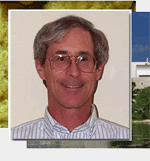James Kremer
(Ph.D., University of Rhode Island) Professor of Marine Sciences, emeritus
I am a coastal systems ecologist. My research focuses on field studies and numerical modeling of interactions among organisms and their environment in a variety of coastal ecosystems. I have studied temperate estuaries, shallow lagoons, a kelp forest, a tropical sandy bottom community and the oceanic plankton system. The unifying theme of my studies is to improve our understanding of how spatial and temporal patterns in the physical and chemical environment control productivity in marine systems.
In the marine environment, understanding ecological dynamics requires insight into biological responses to nutrients as well as physical forces like light, temperature and water movement. Thus, my work involves aspects of physics (solar irradiance, heat budgets, air-water gas exchange, hydrodynamics) and chemistry (abiotic fluxes of organic and inorganic forms of nitrogen, oxygen and carbon), in addition to the physiological responses of plants and animals and their trophic interactions. Numerical simulation is an indispensable tool in ecosystem studies, but my modeling perspective remains that of an ecologist rather than a mathematician or statistician.
An area of my current research is to understand the chain of events connecting changing patterns of land use in coastal watersheds to the dramatic ecological transformations occurring in our coastal waters. At least 50% of the U.S. population lives in the coastal zone, and the resulting eutrophication may be the single most pervasive impact in these productive ecosystems. Field studies are needed to document quantitatively how these impacts are expressed in terms of nutrient levels, the shifting dominance of vascular plants, macroalgae and phytoplankton as primary producers, and other effects up the food chain. Deploying automatic recording instruments help us to make measurements of physical, chemical and biological variables at a number of sites over time intervals sufficient to be ecologically (and statistically) meaningful. Computer models relate changes in the watershed to the delivery of nitrogen, a critically important nutrient in marine waters, and in turn, to the changes in the aquatic system resulting from this eutrophication. The models can serve as the basis for more informed management decisions and policy.
Research Projects
Eelgrass habitat and ecosystem metabolism in relation to nitrogen loading in shallow embayments and estuaries of Long Island Sound – Connecticut Department of Environmental Protection, Non-point source pollution initiative
LISICOS: Toward a Long Island Sound Integrated Coastal Observing System Linking Science Policy and the Public to LIS – National Oceanic and Atmospheric Administration
A biological-physical numerical simulation model for the investigation, prediction, and management of pelagic oxygen and consumption in Long Island Sound: Data analysis and model formulation – Environmental Protection Agency / Connecticut Sea Grant
Modeling tools to understand and manage hypoxia: Application to Narragansett Bay – Environmental Protection Agency, Hypoxia program
Oceanography Alumni
Alison B. Branco – Ph.D. 2007
Jamie Vaudrey – Ph.D. 2007
Publications
Kremer, J.N. and S.W. Nixon. 1978. A Coastal Marine Ecosystem: Simulation and Analysis. Ecological Studies Vol. 24. Springer-Verlag, Heidelberg. 217 pp.
D’Avanzo and J.N. Kremer. 1994. Diel oxygen dynamics and anoxia Waquoit Bay, a eutrophic embayment on Cape Cod, MA. Estuaries 17(1B): 131-139.
D’Avanzo, J.N. Kremer, S.C. Wainright. 1996. Ecosystem production and respiration in response to eutrophication in shallow temperate estuaries. Mar. Ecol. Prog. Ser., 141:263-274.
Lansing, J.S. and J.N. Kremer. 1995. The Goddess and the Green Revolution. In: 1996 Yearbook of Science and Technology and the Future. Encyclopedia Britannica. Chicago. p. 198-219.
Valiela, I., G. Collins, J. Kremer, K. Lajtha, M. Geist, B. Seely, J. Brawley, C. Sham, 1996. Nitrogen loading from coastal watersheds to receiving estuaries: new method and application. Ecological Applications, 7(2):358-380.

| james.kremer@uconn.edu | |
| Phone | 646-241-4614 |